
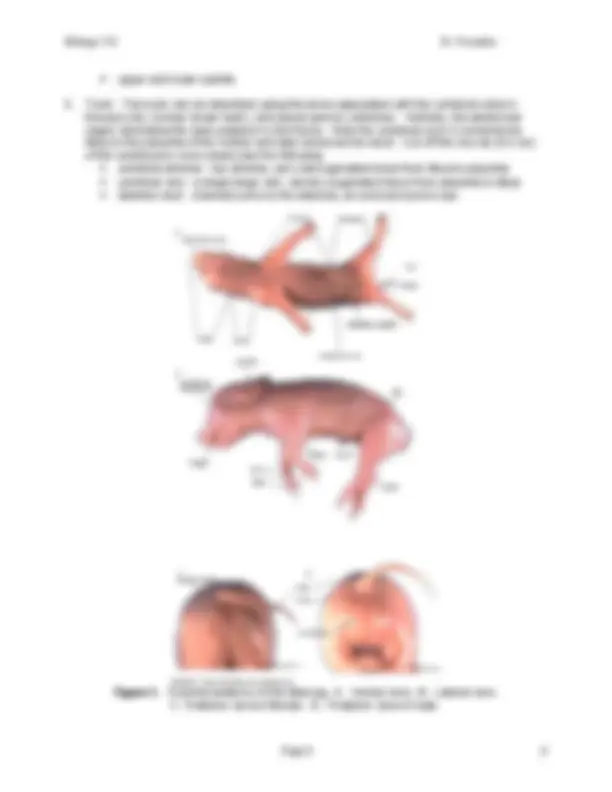
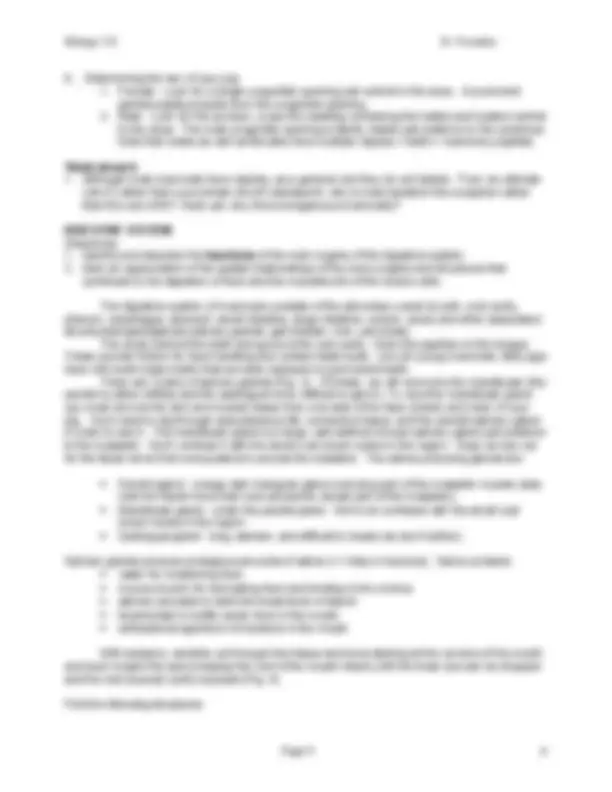
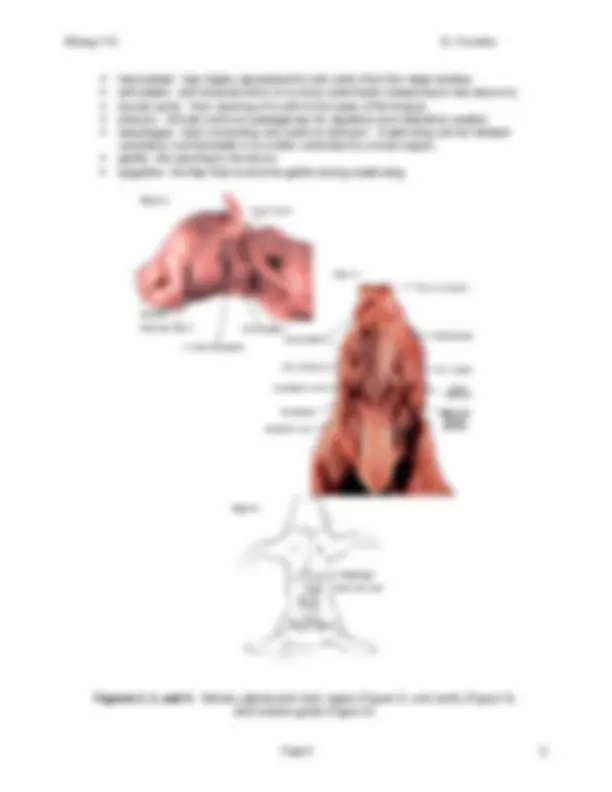
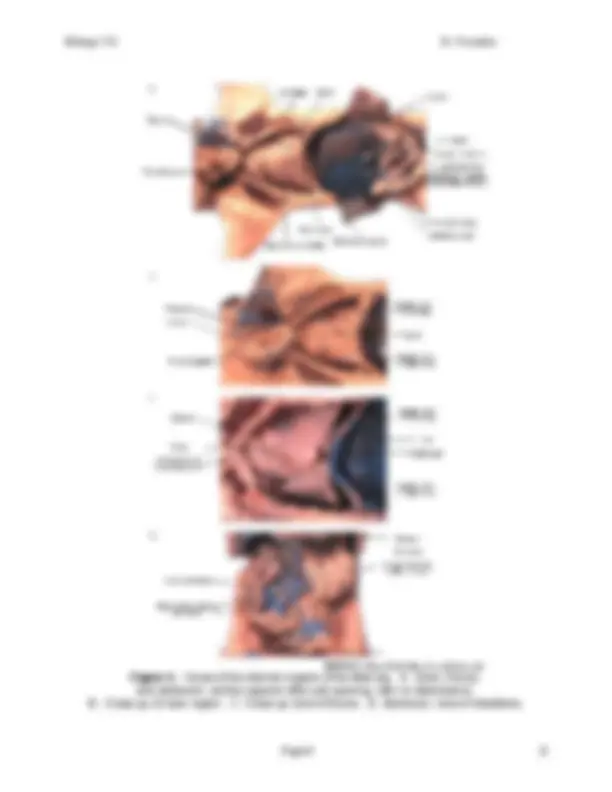
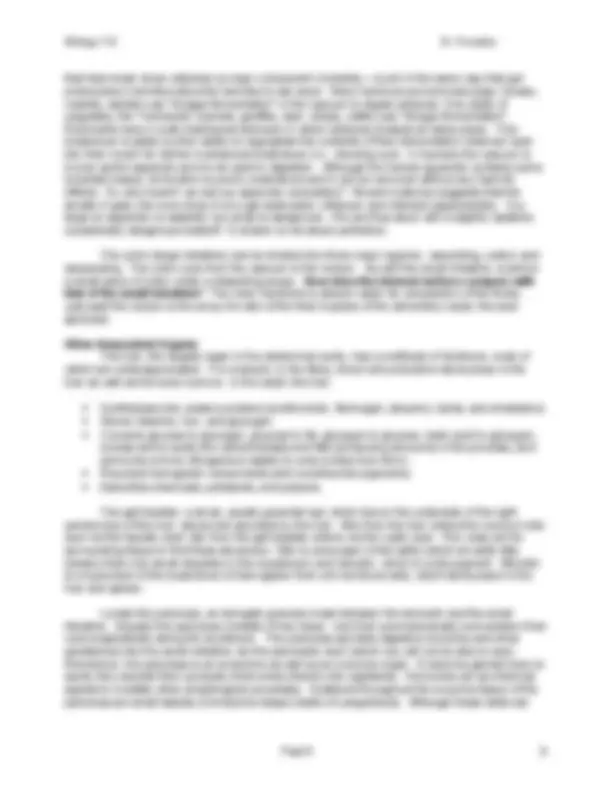
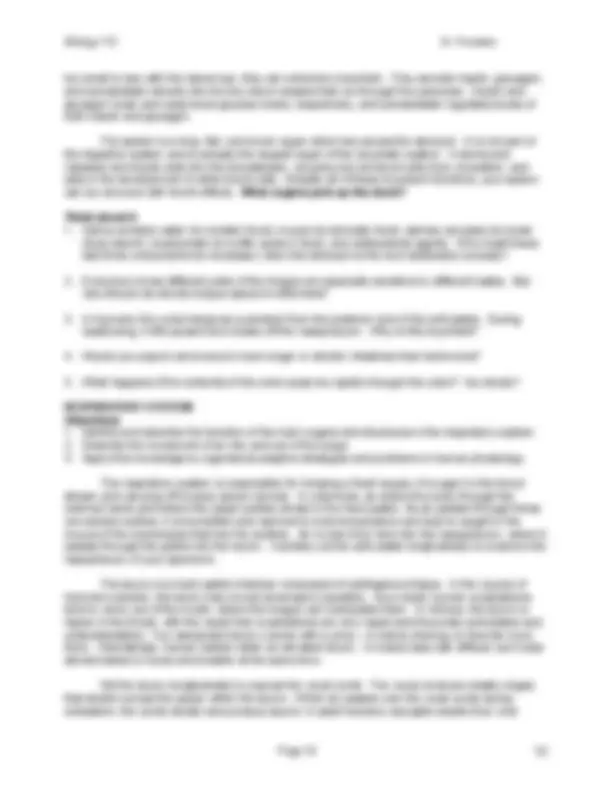
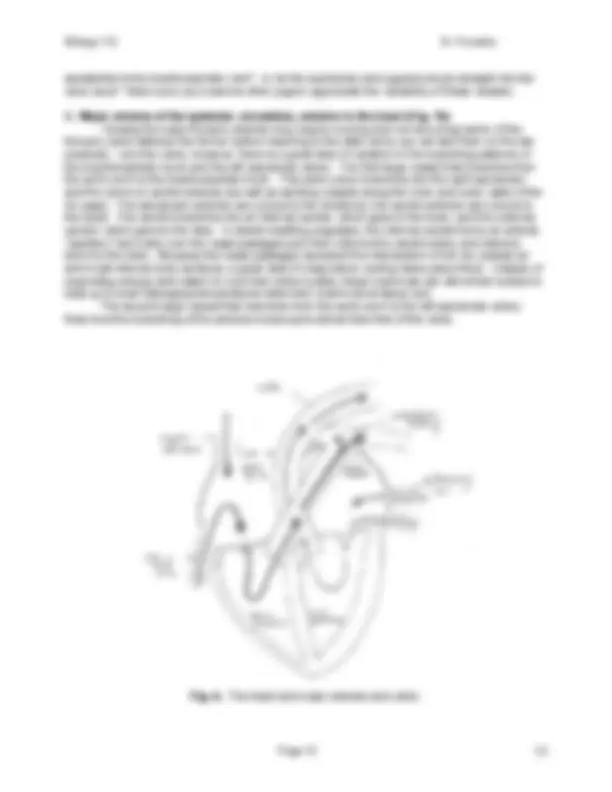
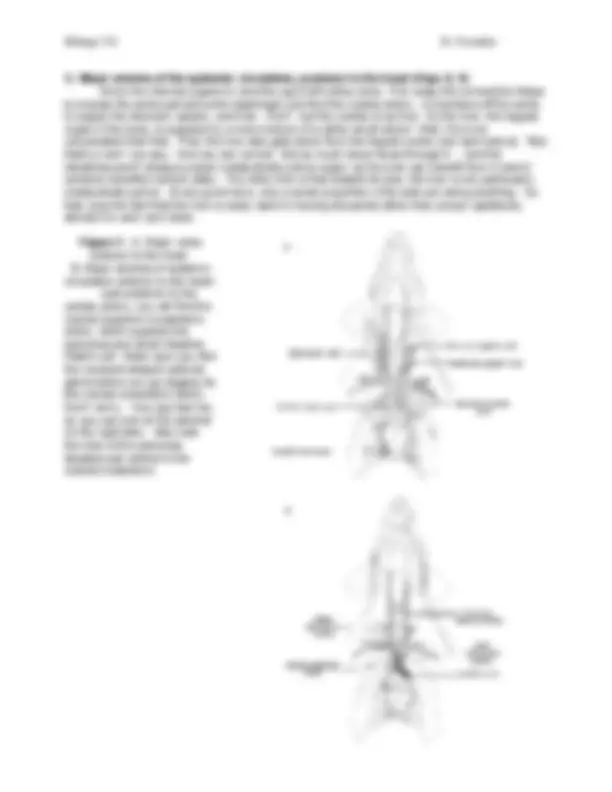
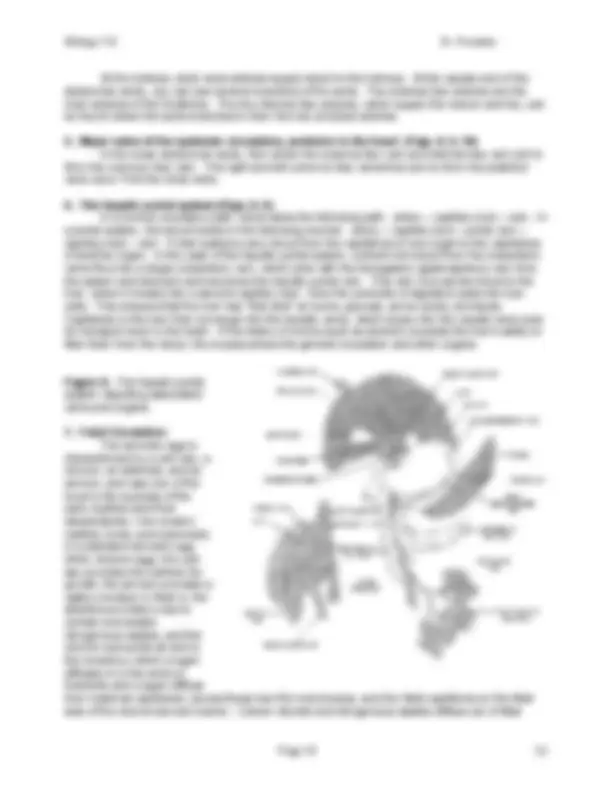
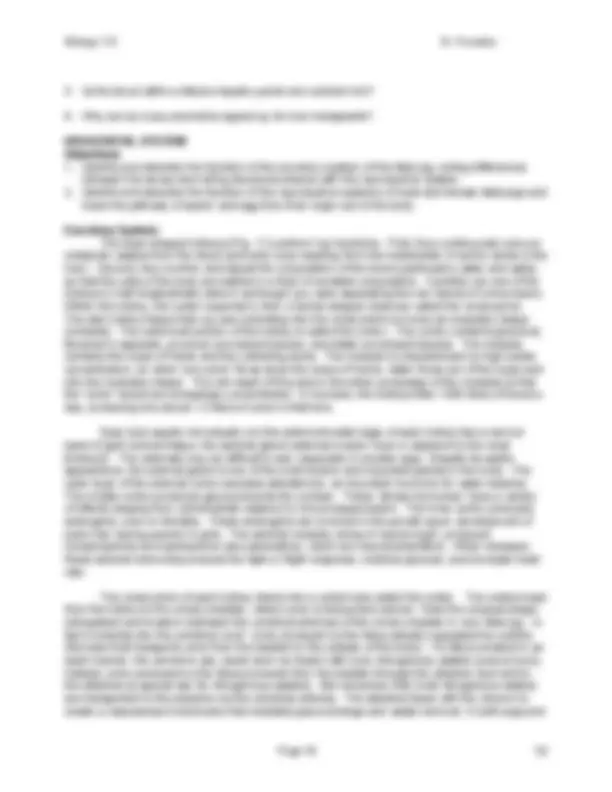
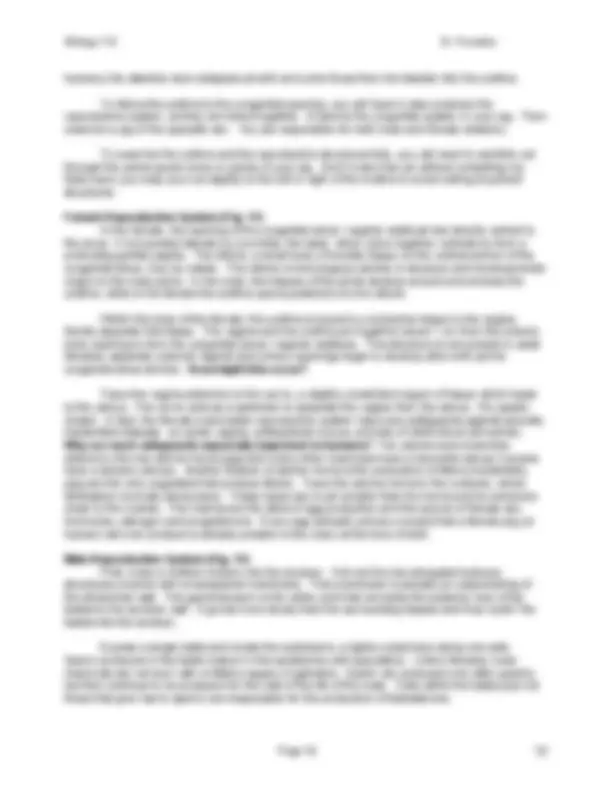
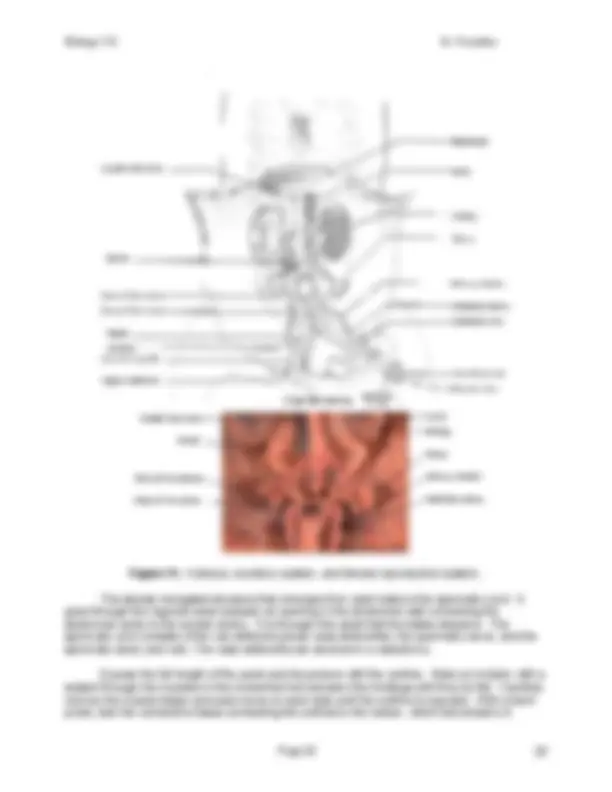
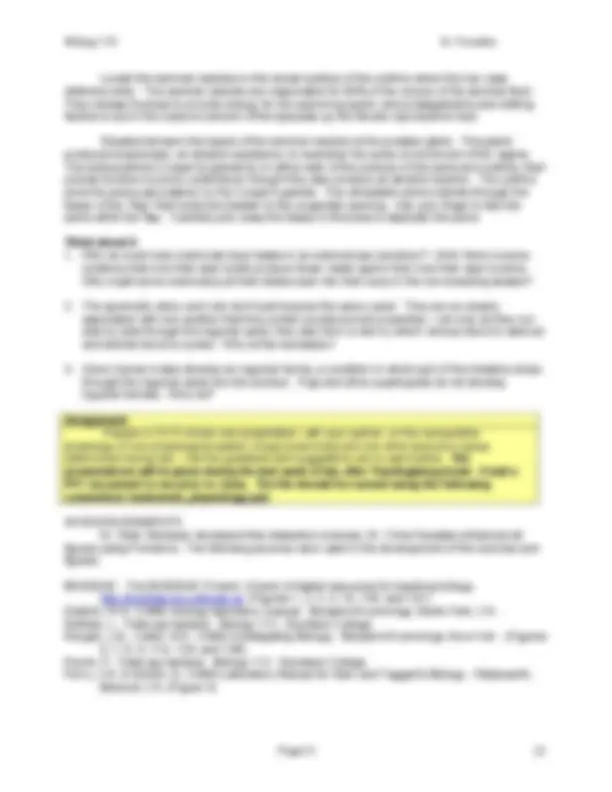
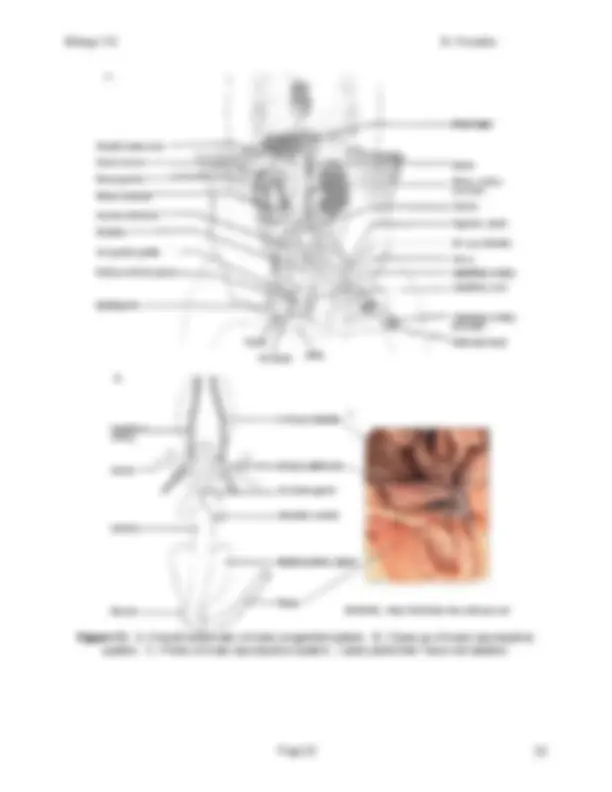


Study with the several resources on Docsity

Earn points by helping other students or get them with a premium plan


Prepare for your exams
Study with the several resources on Docsity

Earn points to download
Earn points by helping other students or get them with a premium plan
Community
Ask the community for help and clear up your study doubts
Discover the best universities in your country according to Docsity users
Free resources
Download our free guides on studying techniques, anxiety management strategies, and thesis advice from Docsity tutors
Material Type: Lab; Professor: Stanback; Class: Organisms,Evolution,Ecosystems; Subject: Biology; University: Davidson College; Term: Unknown 1989;
Typology: Lab Reports
1 / 22

This page cannot be seen from the preview
Don't miss anything!















Exercise 7: Fetal Pig Anatomy Developed by Dr. Mark Stanback
INTRODUCTION In this exercise, you will examine in some detail the external and internal anatomy of a fetal pig (Sus scrofa). As the pig is a mammal, many aspects of its structural and functional organization are identical with those of other mammals, including humans. Thus, a study of the fetal pig is in a very real sense, a study of humans.
The fetuses you will use were salvaged from pregnant sows being slaughtered for food. They are not raised specifically for dissection purposes. The fetuses are removed from the sow and embalmed with a preservative, which is injected through the umbilicus. Following this, the arterial and venous systems are injected under pressure with latex, a rubber-like compound. Arteries (red) are injected through the umbilicus; veins (blue) are injected through one of the jugular veins at the base of the throat.
With the possible exception of the abdominal cavity, organs rarely appear as they are presented in a diagram. If the purpose of this exercise were simply to have you memorize diagrams (or computer screens), we could bypass the expense, time, and controversy of dissecting! Dissection is a powerful teaching method, especially for concrete thinkers and visual learners. Only by dissecting can you really appreciate the structural and functional role of the many membranes, mesenteries, and connective tissues that will impede your progress every step of the way. Only by dissecting can you really appreciate the relationship between an organ's texture, location, and function. I do not take the life (or death) of your pig specimen lightly – this is why I demand that you take your dissection seriously and utilize your pig to the fullest extent.
During these exercises, keep several points in mind. First, be aware that "to dissect" does not mean "to cut up," but rather primarily "to expose to view." Actual cutting should be kept to a minimum. Tissues are picked and teased apart with needle probes, forceps, and blunt probes in order to trace the pathways of blood vessels, nerves, muscles, and other structures. Never cut or move more than is necessary to expose a given part. Second, pay particular attention to the spatial relationships of organs, glands, and other structures as you expose them. Realize that their positions are not random. Third, we encourage you to engage in collaborative discussions with your classmates and compare dissections.
In many cases the figures contain more information than you need to know. Don't panic – this extra information is provided to help you identify what you do need to know. If you wish to explore your pig more thoroughly and identify additional structures (e.g., blood vessels), please do! Each lab group will be provided with a color photograph dissection manual to supplement this handout. By the end of this exercise you should have a very good grasp of the connections between physiological processes and organ structure/function.
At the end of each major section, we have produced a set of questions (Think about it). Additionally, there are boldface questions scattered through the text. Make sure you figure out the answers to these questions before moving on. All are fair game for the practical.
SAFETY AND HYGIENE
MATERIALS fetal pig dissecting tray dissection kit (scissors, scalpel, blunt probe, needle probe, forceps) lab gloves paper towels string
OBJECTIVES
EXTERNAL FEATURES
Think about it
DIGESTIVE SYSTEM Objectives:
The digestive system of mammals consists of the alimentary canal (mouth, oral cavity, pharynx, esophagus, stomach, small intestine, large intestine, rectum, anus) and other associated structures/organs/glands (salivary glands, gall bladder, liver, pancreas). The cavity behind the teeth and gums is the oral cavity. Note the papillae on the tongue. These provide friction for food handling and contain taste buds. Like all young mammals, fetal pigs have milk teeth (baby teeth) that are later replaced by permanent teeth. There are 3 pairs of salivary glands (Fig. 2). Of these, we will view only the mandibular (the parotid is rather diffuse and the sublingual is too difficult to get to). To view the mandibular gland you must remove the skin and muscle tissue from one side of the face (cheek) and neck of your pig. You’ll need to dig through subcutaneous fat, connective tissue, and the parotid salivary gland in order to see it. The mandibular gland is a large, well-defined circular salivary gland just posterior to the masseter. Don’t confuse it with the small oval lymph nodes in the region. Keep an eye out for the facial nerve that runs posteriorly across the masseter. The saliva producing glands are:
Salivary glands produce prodigious amounts of saliva (>1 l/day in humans). Saliva contains:
With scissors, carefully cut through the tissue and bone starting at the corners of the mouth and back toward the ears (keeping the roof of the mouth intact) until the lower jaw can be dropped and the oral (buccal) cavity exposed (Fig. 3).
Find the following structures:
Figures 2, 3, and 4. Salivary glands and neck region (Figure 2), oral cavity (Figure 3), and incision guide (Figure 4).
Examine the neck, thoracic, and abdominal regions of your pig (Fig. 5). First find the thymus gland, which partially covers the anterior portion of the heart and extends along the trachea to the larynx. The thymus plays an important role in the development and maintenance of the immune system – this is where white blood cells mature into antibody-producing T-lymphocytes.
Immediately beneath the thymus in the neck is the thyroid gland, a small,solid, reddish, oval mass. The thyroid secretes thyroxine, which in mammals influences the metabolic rate of cells, which in turn influences growth and development. Because iodine is necessary for the production of thyroxine, our salt is often iodized. If synthesis of thyroxine declines (e.g. due to a lack of iodine), the anterior pituitary increases the release of thyroid stimulating hormone (TSH). This may stimulate the proliferation of thyroid cells, but if there is no iodine, thyroxine production will not increase, which causes additional TSH release. The thyroid also produces calcitonin, a hormone that stimulates osteoblasts to lay down bone. The consequence of this activity is a surprisingly rapid decline in blood calcium levels. If blood Ca levels drop too low, or if extra Ca is needed, the parathyroid glands release parathormone. The parathyroid is not a discrete organ in mammals – parathyroid tissue is embedded in the thyroid. Parathormone raises blood Ca levels by activating osteoclasts, by stimulating Ca resorption in the kidney, and by activating vitamin D to enhance absorption of Ca from food.
In the neck find the trachea and use it as a landmark to locate the esophagus. Make a small incision in the esophagus in the throat and insert a blunt probe anteriorly; note where it emerges in the oral cavity.
Insert the blunt probe through this incision posteriorly toward the stomach (you will need to move the liver to one side to fully expose the stomach). Note that the esophagus penetrates the diaphragm before entering the stomach. Cut open the stomach lengthwise with your scissors. The contents of a fetus's digestive tract is called meconium, composed of a variety of substances including bile stained mucus, amniotic fluid, sloughed epithelial cells, and hair. Clean out the stomach and note the folds (rugae). What role might the rugae play? Many glands that secrete pepsinogen and hydrochloric acid are embedded in the wall of the stomach.
Two muscular rings (smooth muscle), the cardiac (closer to the heart) and the pyloric sphincter (adjoining the small intestine), control the movement of food through the stomach.
The majority of digestion and absorption takes place in the small intestine. It is composed of the duodenum, the jejunum, and the ileum, the latter two being difficult to distinguish. The duodenum, into which bile and enzymes from the gall bladder and pancreas enter, passes posteriorly and then curves to the left. The coils of the small intestine are held together by mesenteries. A rule of thumb is that the small intestine in both pigs and humans (omnivores) is about five times the length of the body. Note the lymph nodes embedded in the mesenteries. These nodes filter pathogens from the lymph.
Cut a 0.5 cm section of the small intestine, slit it lengthwise, and place it in a clear shallow dish filled with water. Examine it with a dissecting microscope. How does the inner surface appear? Locate the villi, the absorptive projections on the inner surface. A microscopic view of the villi shows microvilli, which further enhance their absorptive capacity (surface area). Villi contain both capillaries and lacteals. What are lacteals and into what system do they empty?
Locate the caecum, a small blind-ended sac found at the juncture of the ilium and the colon (large intestine). This juncture is also the site of the ileocecal valve. Feel for it by rolling the junction between your index finger and thumb. In the pig, the caecum houses bacterial symbionts
Figure 5. Views of the internal organs of the fetal pig. A. Neck, thorax, and abdomen, as they appear after just opening, with no disturbance. B. Close-up of neck region. C. Close-up view of thorax. D. Abdomen, view of intestines.
too small to see with the naked eye, they are extremely important. They secrete insulin, glucagon, and somatostatin directly into the tiny blood vessels that run through the pancreas. Insulin and glucagon lower and raise blood glucose levels, respectively, and somatostatin regulates levels of both insulin and glucagon.
The spleen is a long, flat, red-brown organ which lies across the stomach. It is not part of the digestive system and is actually the largest organ of the lymphatic system. It stores and releases red bloods cells into the bloodstream, recycles old red blood cells from circulation, and aids in the development of white blood cells. Despite all of these important functions, your spleen can be removed with few ill effects. What organs pick up the slack?
Think about it
RESPIRATORY SYSTEM Objectives
The respiratory system is responsible for bringing a fresh supply of oxygen to the blood stream and carrying off excess carbon dioxide. In mammals, air enters the body through the external nares and enters the nasal cavities dorsal to the hard palate. As air passes through these convoluted cavities, it is humidified and warmed to body temperature and dust is caught in the mucus of the membranes that line the cavities. Air moves from here into the nasopharynx, where it passes through the glottis into the larynx. Carefully cut the soft palate longitudinally to examine the nasopharynx of your specimen.
The larynx is a hard-walled chamber composed of cartilaginous tissue. In the course of hominid evolution, the larynx has moved downward (caudally). As a result, human vocalizations tend to come out of the mouth, where the tongue can manipulate them. In chimps, the larynx is higher in the throat, with the result that vocalizations are very nasal (and thus less controllable and understandable). Our descended larynx comes with a price – it makes choking on food far more likely. Interestingly, human babies retain an elevated larynx. It makes baby talk difficult, but it also allows babies to nurse and breathe at the same time.
Slit the larynx longitudinally to expose the vocal cords. The vocal cords are elastic ridges that stretch across the space within the larynx. When air passes over the vocal cords during exhalation, the cords vibrate and produce sound. In adult humans, laryngitis results from viral
infection of the vocal cords. They swell and regular speech is difficult to impossible.
Read the following information about the respiratory system. However, do not attempt to identify structures other than the trachea until you have exposed the heart and its major vessels (see Circulatory System further below).
The trachea, distinguished by its cartilaginous rings (incomplete on the dorsal side), divides into the two bronchi (singular bronchus), which enter the lungs and divide into bronchioles (don’t try to find the bronchi until you’ve finished examining the heart and its major vessels). Bronchioles terminate in alveoli, where gas exchange takes place.
The right lung typically consists of four lobes and the left of two or three. How many does your pig have? The lungs in your fetal pig are small and fairly solid because they have never been inflated. Inflation causes lungs to have a spongy appearance. Note the position of the diaphragm in relation to the lungs. Contraction of the diaphragm enlarges the thoracic cavity and pulls air into the lungs. Remember that only mammals have a true muscular diaphragm; other terrestrial vertebrates use a variety of methods to inflate their lungs.
Examine the lungs and note the pleural membranes (one lining the inner surface of the pleural cavity and the other covering the outer surface of the lung). As mentioned earlier, the intrapleural space is filled with fluid. This fluid allows the membranes to slide freely across each other, much like two wet panes of glass (easy to slide, hard to separate), and allows them to maintain contact. This ensures that the lungs will inflate when the thoracic cavity expands as a result of diaphragmatic contraction or expansion of the rib cage.
When neonatal mammals inhale for the first time, their lungs inflate. When they then exhale, the lungs don’t deflate all the way. That’s because pulmonary surfactants reduce the surface tension of water (just like soap does – you can float a bottlecap on water until you add a surfactant like soap). In this case the water is in the form of a film that coats each and every alveolus. If it weren’t for these surfactants, the surface tension of this layer would collapse the delicate alveoli – causing the lungs to “collapse” after each breath. This surfactant is produced by the lungs during the last part of pregnancy.
Think about it
CIRCULATORY SYSTEM Objectives
substantial is the brachiocephalic vein? or do the subclavian and jugulars empty straight into the vena cava? Make sure you examine other pigs to appreciate the variability of these vessels.
Fig. 6. The heart and major arteries and veins.
Figure 7. A. Major veins anterior to the heart. B. Major arteries of systemic circulation anterior to the heart. Just posterior to the coeliac artery, you will find the cranial (superior) mesenteric artery, which supplies the pancreas and small intestine. Watch out! Make sure you find the crescent-shaped adrenal gland before you go digging for the cranial mesenteric artery. Don’t worry. Your pig has two, so you can look at the adrenal on the right later. Also note the lobe of the pancreas situated just ventral to the cranial mesenteric.
capillaries and across into maternal blood. Fetal and maternal blood never mix (this is why mothers and their children can have different blood types). Nutrients and gases must diffuse across maternal capillary walls, the uterine tissue, the chorion, and finally the fetal capillary walls. In primates, the uterine wall and maternal capillaries break down. Thus in humans, fetal capillaries are separated from maternal blood by only a thin chorionic layer.
Figures 9 and 10. 9. Hepatic portal system. 10A. Fetal and renal circulation. 10B. Posterior circulation.
The umbilical vein carries oxygen- and nutrient-rich blood from the fetal side of the placenta to the fetus. However, this relatively well-oxygenated blood mixes with deoxygenated fetal blood before it enters fetal arterial circulation. The first site of mixing is within the liver, and the mixed blood continues on to the caudal (posterior) vena cava. Here it mixes with deoxygenated blood from the rest of the body on its way to the heart. Finally, within the right atrium, this blood is once more mixed with deoxygenated blood, this time from the cranial (anterior) vena cava.
How do mammalian fetal tissues survive in such a low oxygen environment? The answer lies in their red blood cells. Fetuses have a different kind of hemoglobin than do adult mammals. Fetal hemoglobin has a higher affinity for oxygen than does adult hemoglobin; it is still able to pick up oxygen molecules when environmental oxygen levels are very low (levels at which maternal hemoglobin is shedding oxygen). On the flip side, fetal hemoglobin holds oxygen until tissues are on the verge of oxygen deprivation.
In the fetus, the pulmonary circuit is not functional and is therefore bypassed. About half of the blood entering the right atrium flows directly into the left atrium via the foramen ovale (it is not necessary for you to find this small opening, but you can try). From here it moves into the left ventricle, then the aorta, and out into the systemic circulation. The remainder of the blood entering the right atrium flows into the right ventricle and out to the pulmonary trunk. However, instead of flowing on to the pulmonary artery and the lungs, this blood bypasses the pulmonary artery and goes through the ductus arteriosus into the aorta, where it enters systemic circulation.
So…to review… the most oxygenated blood is in the umbilical vein. It mixes (rather counterintuitively) with the very deoxygenated blood of the posterior vena cava. Thus the posterior vena cava just posterior to the heart is more oxygenated than the anterior vena cava just anterior to the heart. The aorta is thus less oxygenated than the anterior portion of the posterior vena cava! Even more strange, the aorta sends a great deal of rather oxygenated blood straight back to the placenta (via the umbilical arteries). You’d think the fetus would send deoxygenated vena cava blood to the placenta to get oxygen, but nope! It sends oxygenated aorta blood! Remember though, the blood pressure in the vena cava is essentially zero … and that capillary beds work better when there is a blood pressure differential between the arterial and venous sides. The aorta provides that blood pressure.
Think about it
humans, the allantoic duct collapses at birth and urine flows from the bladder into the urethra.
To follow the urethra to the urogenital opening, you will have to also examine the reproductive system, as they are linked together. Examine the urogenital system in your pig. Then examine a pig of the opposite sex. You are responsible for both male and female anatomy.
To examine the urethra and the reproductive structures fully, you will need to carefully cut through the pelvis (pubic bone or pubis) of your pig. Don’t make this cut without consulting me. Make sure you keep your cut slightly to the left or right of the midline to avoid cutting important structures.
Female Reproductive System (Fig. 11) In the female, the opening of the urogenital sinus / vaginal vestibule lies directly ventral to the anus. It is bounded laterally by low folds, the labia, which come together ventrally to form a protruding genital papilla. The clitoris, a small body of erectile tissue on the ventral portion of the urogenital sinus, may be visible. The clitoris is homologous (similar in structure and developmental origin) to the male penis. In the male, the tissues of the penis develop around and enclose the urethra, while in the female the urethra opens posteriorly to the clitoris.
Within the body of the female, the urethra is bound by connective tissue to the vagina. Gently separate this tissue. The vagina and the urethra join together about 1 cm from the exterior body opening to form the urogenital sinus / vaginal vestibule. This structure is not present in adult females--separate external vaginal and urinary openings begin to develop after birth as the urogenital sinus shrinks. How might this occur?
Trace the vagina anteriorly to the cervix, a slightly constricted region of tissue which leads to the uterus. The cervix acts as a sphincter to separate the vagina from the uterus. It's usually closed. In fact, the female mammalian reproductive system has many safeguards against sexually transmitted disease: an acidic vagina, antibacterial mucus, and lots of white blood cell activity. Why are such safeguards especially important in humans? The uterine body branches anteriorly into two uterine horns (pigs and many other mammals have a bicornate uterus; humans have a simplex uterus). Another feature of uterine horns is the production of litters (incidentally, pigs are the only ungulates that produce litters). Trace the uterine horns to the oviducts, where fertilization normally takes place. These tubes are much smaller than the horns and lie extremely close to the ovaries. The ovaries are the sites of egg production and the source of female sex hormones, estrogen and progesterone. Every egg (actually primary oocyte) that a female pig (or human) will ever produce is already present in the ovary at the time of birth.
Male Reproductive System (Fig. 12) First, make a midline incision into the scrotum. Pull out the two elongated bulbous structures covered with a transparent membrane. This membrane is actually an outpocketing of the abdominal wall. The gubernaculum is the white cord that connects the posterior end of the testes to the scrotum wall. It grows more slowly than the surrounding tissues and thus "pulls" the testes into the scrotum.
Expose a single testis and locate the epididymis, a tightly coiled tube along one side. Sperm produced in the testis mature in the epididymis until ejaculation. Unlike females, male mammals are not born with a lifetime supply of gametes. Sperm are produced only after puberty, but then continue to be produced for the rest of the life of the male. Cells within the testis (but not those that give rise to sperm) are responsible for the production of testosterone.
Figure 11. Kidneys, excretory system, and female reproductive system.
The slender elongated structure that emerges from each testis is the spermatic cord. It goes through the inguinal canal (actually an opening in the abdominal wall connecting the abdominal cavity to the scrotal cavity). It is through this canal that the testes descend. The spermatic cord consists of the vas deferens (plural vasa deferentia), the spermatic nerve, and the spermatic artery and vein. The vasa deferentia are severed in a vasectomy.
Expose the full length of the penis and its juncture with the urethra. Make an incision with a scalpel through the muscles in the midventral line between the hindlegs until they lie flat. Carefully remove the muscle tissue and pubic bone on each side until the urethra is exposed. With a blunt probe, tear the connective tissue connecting the urethra to the rectum, which lies dorsal to it.